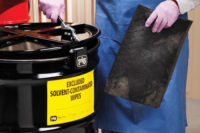Most people don’t need a lot of instruction on how to use wipes. From drying hands in a restroom to wiping dirt and oil from a part before it’s sent for finishing, wipes serve many different yet familiar purposes – both at work and at home.
In some facilities, one type of wipe may be used to perform multiple tasks. In other facilities, several different types of wipes may each be dedicated to a variety of specific tasks. No matter what the scenario, wipes are tools that are used daily to get jobs done.
While it is probably a bit outlandish to do a full process hazard analysis or environmental impact statement on something that in some cases is just a step above a paper towel, being aware of certain safety and environmental principles when selecting and using wipes will help ensure that the right one is being used for the job and that they are being managed safely.
Types of wipes
Wipes have been around for centuries. Their earliest form was rags that were cut from cast-off textiles that were no longer suitable to be used for clothing. As countries became industrialized and factories were created, workers often brought these rags from home to perform work tasks from wiping parts to applying finishes. It was also common for everyone to have a handkerchief or bandana that was in slightly better shape than their work rags to wipe sweat from their foreheads or clean their hands. Rags are still commonly used today, but they are not often brought from home anymore. They are mostly purchased by the pound from rag suppliers and can be made from things like discarded clothing, bed sheets and mill ends from textile and clothing manufacturing facilities.
Shop towels are another wiping option. Similar to rags, shop towels are typically made from woven cotton and are designed to be washed and reused. They usually have sewn or bound edges and are most often delivered as part of a laundering service.
Disposable and pre-moistened wipes offer the widest variety of styles and are most commonly engineered for specific tasks. The substrates for disposable and pre-moistened wipes are varied and include cellulose, polyester, polypropylene and microfibers.
Safety
Wipes can be used to apply or remove thousands of different chemicals such as polishes, thinners and detergents. Knowing the properties of the chemicals that will come in contact with a wipe is important because those properties don’t change just because they’ve been absorbed into a wipe. Corrosive liquids remain corrosive. Flammable liquids remain flammable. Choosing a wipe with an appropriate base, for example, using a polypropylene wipe with corrosives, limits the chance of chemical reactions.
Storing and handling spent wipes safely limits the potential for fires. This is true for both disposable and reusable wipes and is not limited solely to wipes that have been used with solvents or drying oils.
Storing spent wipes in closed containers limits fugitive emissions and helps to prevent the wipes from coming in contact with heat sources, errant sparks or other forms of ignition. It can also help to segregate the wipes for recycling, disposal or laundering.
Laundered shop towels that are not properly cleaned before being returned to the facility for reuse can contain residual chemicals from previous uses. Because shop towels are laundered in large batches and co-mingled with towels from other companies, it’s hard to be certain where the towels in this week’s batch have been. Problems can range from dermatitis if the towels are used by employees to wipe their hands and face, cuts and abrasions from metal shavings embedded in the towels and reactions with residual chemicals that were not fully removed from the towel.
Just as no facility – even one that has a million hours with no lost worktime incidents – is completely safe, there is no wipe that is entirely safe for every situation. But being aware of what a wipe is made of and how the wipe will be used, stored and handled minimizes risk.
Environmental
Facilities that generate wastes are required under the Resource Conservation Recovery Act (RCRA) to make solid and hazardous waste determinations when something that has been stored, processed, used or otherwise managed at the facility is no longer useful. The regulations provide definitions for both solids and hazardous wastes. Wipes that are no longer useful fall under these rules.
After use, wipes can be disposed of, recycled or laundered. Wipes that will be sent for disposal meet the definition of solid waste – unless they’ve been specifically exempted in the regulation.
Facilities that choose to launder and reuse their wipes should verify that their contracted laundering service has systems in place to prevent hazardous wastes from entering the environment. Many launderers now have filtration and separation systems that effectively capture environmental pollutants to prevent them from being discharged or otherwise improperly managed.
EPA modified the hazardous waste management regulations for wipes containing solvents in 2013. In states that have adopted the federal rule, disposable wipes contaminated with solvents are excluded from hazardous waste regulation and reusable wipes are excluded from solid waste regulations when they are managed according to rules in the exemption.
Like hammers, socket wrenches and other tools, there is a wide variety of wipes on the market today. Considering safety and environmental aspects when selecting the right wipe for the job and can help narrow choices while minimizing risks.


